中英方案投标示范-西九龙城市公园福斯特
- 格式:ppt
- 大小:4.81 MB
- 文档页数:12
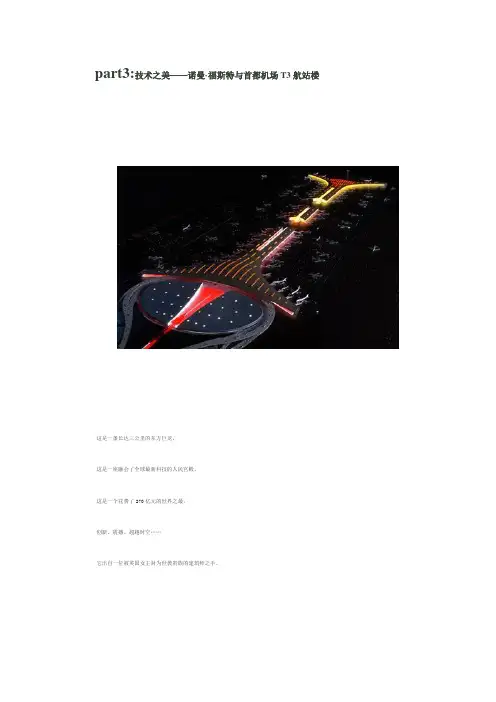
part3:技术之美——诺曼·福斯特与首都机场T3航站楼这是一条长达三公里的东方巨龙,这是一座融会了全球最新科技的人民宫殿,这是一个花费了270亿元的世界之最,创新、震撼、超越时空……它出自一位被英国女王封为世袭贵族的建筑师之手。
2003年11月,英国著名建筑师诺曼·福斯特在2008奥运工程北京新机场的设计竞赛中,脱颖而出,赢得了该项工程的设计招标。
从20世纪80年代起,福斯特已经声名鹊起,他的作品以显著的高科技应用和生态学倾向而著称。
但是,首都机场新航站楼的设计,却成为了这位高技术流派领军人物面临的一次巨大的挑战。
这将是他设计生涯中最大,也是时间最为紧迫的一件作品。
世界上著名的希斯罗机场达到同等规模所花费的时间,几乎是北京首都机场的十倍。
但这位有着飞行员经历的建筑师,却必须在短短的四年之间中,将自己对飞行的理解、丰富的机场设计经验、高科技手段的应用,与中国的传统文化结合在一起。
他要设计的不仅是一座复杂的大型枢纽机场,同时也是中国的一道国门,是北京形象的一个代表。
在北京市东北方的首都机场,一座占地近一百万平方米的巨大建筑正在拔地而起。
这就是正在修建的首都机场3号航站楼。
这一建筑呈现出中国最传统的吉祥之物——龙的形状,屋顶长3.25千米,宽785米,其面积是现有1、2号航站楼总和的两倍之多。
曾有报道称,“这将是全世界最大的有顶建筑。
有4万个工人在那里按8小时轮班工作。
建造时间从2004年4月6日开始,将于2007年12月31日封顶,刚好迎接2008年北京奥运会。
”首都机场三期的设计者福斯特是位完美主义者,他的建筑设计都是集体的结晶,由结构工程师、设备工程师和造价顾问共同完成,而福斯特在其中扮演的角色是统帅。
他的建筑事务所可以说是世界最大的建筑、规划和设计公司,已荣获了280多项奖励,赢得了50多次国际设计竞赛,工程遍及全球。
其代表性作包括:德国新议会大厦;大不列颠博物馆大厅;汇丰银行香港和伦敦总部;德意志商业银行总部;加里艺术中心;香港新机场等等。

一、规划三剑客西九文化区概念规划方案香港西九文化区的建设项目恐怕是当今世界上规模最大,最雄心勃勃,也是一直富于争议性的文化建设项目。
8月20日,备受关注的文化区三个规划方案终于出台了!三家规划设计顾问公司——英国的Foster + Partners(以下简称福斯特),香港的许李严建筑师事务有限公司(以下简称许李严或严讯奇)和荷兰的OMA(以下称OMA或库哈斯),各自领取酬金约4,900万港元,经过一年的闭门铸造,终于向香港公众亮出自己的绝招。
三个概念规划方案自8月21日起在香港会展中心等地展出,进行为期三个月的公众咨询,收集市民意见,最后西九文化区管理局将“综合各方意见”选取一个主导方案。
“西九兴亡,匹夫有责”。
我去仔细看了展览,研读了各设计公司提供的资料,产生一些个人看法,想提出来,与大家交换意见。
在直接讲我个人看法前,我认为有必要先分析一下基地的现状——这是我评判各方案的出发点。
西九头顶几大怪我们香港城市有诸多特色,其中包含两大精髓:便利的公共交通和生机勃勃的街道文化。
前者体现为发达的地铁、公交、电车、航船线路以及相互间便捷的接驳;后者体现为密集的街道网络、频繁出现的街道交叉口、小尺度的街区划分、沿街多样的小商业设施、以及——很重要的——似乎永远都不缺的人气——步行人流。
有时走在铜锣湾、旺角的街道,我也会觉得有点太过拥挤。
也许人口密度稍低点,街道稍宽些会让人更感舒适。
但这只是个度的调整问题,香港街道文化的本质构成总的说来是值得我们珍惜的。
总之,便利的交通加上街道文化这两大精髓,结合其它特征,形成的良好城市空间格局在港岛、九龙比比皆是。
但是,西九文化区周边的城市环境现状如何?相信去过的人大多会同意我,也有两大特点,与香港的城市精髓恰恰相反:极差的公共交通通达性和极端反人性的步行环境!与紧靠东边的尖沙咀和油麻地两个片区的小尺度街区划分、密集的街道网络、方便步行的街区环境、热闹非凡的街道生活相比,西九片区简直就是城市生活的死角和荒漠。
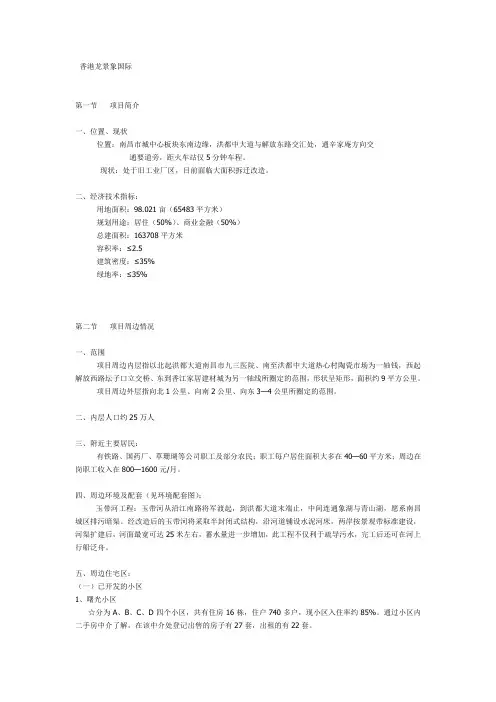
香港龙景象国际第一节项目简介一、位置、现状位置:南昌市城中心板块东南边缘,洪都中大道与解放东路交汇处,通辛家庵方向交通要道旁,距火车站仅5分钟车程。
现状:处于旧工业厂区,目前面临大面积拆迁改造。
二、经济技术指标:用地面积:98.021亩(65483平方米)规划用途:居住(50%)、商业金融(50%)总建面积:163708平方米容积率:≤2.5建筑密度:≤35%绿地率:≤35%第二节项目周边情况一、范围项目周边内层指以北起洪都大道南昌市九三医院、南至洪都中大道热心村陶瓷市场为一轴钱,西起解放西路坛子口立交桥、东到香江家居建材城为另一轴线所圈定的范围,形状呈矩形,面积约9平方公里。
项目周边外层指向北1公里、向南2公里、向东3—4公里所圈定的范围。
二、内层人口约25万人三、附近主要居民:有铁路、国药厂、草珊瑚等公司职工及部分农民;职工每户居住面积大多在40—60平方米;周边在岗职工收入在800—1600元/月。
四、周边环境及配套(见环境配套图):玉带河工程:玉带河从沿江南路将军渡起,到洪都大道末端止,中间连通象湖与青山湖,愿系南昌城区排污暗渠。
经改造后的玉带河将采取半封闭式结构,沿河道铺设水泥河床,两岸按景观带标准建设,河渠扩建后,河面最宽可达25米左右,蓄水量进一步增加,此工程不仅利于疏导污水,完工后还可在河上行船泛舟。
五、周边住宅区:(一)已开发的小区1、曙光小区☆分为A、B、C、D四个小区,共有住房16栋,住户740多户,现小区入住率约85%。
通过小区内二手房中介了解,在该中介处登记出售的房子有27套,出租的有22套。
2、新世纪小区☆共有住房37栋,住户1700余户,小区内环境较差,间距小,户型欠佳,其中10栋为民航团购。
入住率约50—60%。
3、御景城☆共有住房28栋,住户1200余户,小区内环境较好,幼儿园、游泳池等生活配套较齐全。
入住率达90%。
4、草珊瑚职工住宅小区、☆草珊瑚厂工有职工1000多人,公司现已被改制收买;职工小区目前只剩下不到80户未拆迁,居住面积在40—60平方米/套。
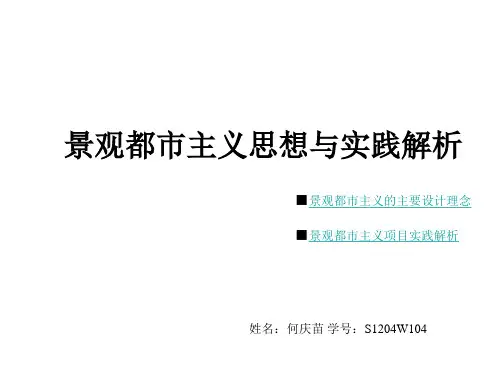

艺术设计美学平时作业学生姓名卢影专业艺术设计学号101131215学院文学院2011年 11月目录诺曼·福斯特及香港汇丰银行大厦----------诺曼·福斯特简介诺曼·福斯特的建筑观诺曼·福斯特所获荣誉香港汇丰银行大厦所获奖项诺曼·福斯特的建筑历程香港汇丰银行大厦创办企业诺曼·福斯特作品----------香港汇丰银行大厦基本信息香港汇丰银行大厦历史香港汇丰银行大厦建筑设计香港汇丰银行大厦超级风水局设计师应具备的设计素养--------------美国著名设计师A·J·普洛斯总结出设计师应具备的基本素质设计师的基本素质设计师的基本能力设计师的专业知识结构道德与实践诺曼·福斯特诺曼·福斯特Norman Foster建筑学学士(曼彻斯特大学),建筑学硕士(耶鲁大学),英国皇家建筑师学会会员。
诺曼·福斯特生于1935年,在曼彻斯特大学学习建筑学和城市规划,1961年毕业后获亨利奖学金去耶鲁大学学习,在那里取得了硕士学位,1963年开设自己的事务所之前,他一直在美国东西海岸从事城市更新和总体规划项目。
诺曼.福斯特获得过全世界许多大学和组织的荣誉学位门奖金。
他于1990年被女王封为爵士,1983年获得皇家金质奖章1994年获美国建筑师学会金质奖章。
他是众多学术团体的成员,在世界许多地方进行教学和讲学。
他曾任建筑协会的副主席以及英国皇家建筑师学会的客座审查委员。
一.建筑观“我认为建筑应该给人一种强调的感觉,一种戏剧性的效果,给人带来宁静。
机场是一个旅行的场所,它必须有助于将航空旅行从一个烦恼的过程变成一种轻松愉快的体验。
如果你到施坦斯德机场,你肯定会享受到自然光的趣味,会看到清晰的屋顶结构形式,你就像回到了过去的那种挡雨采光的老式机场。
许多东西都是仿照这种形式,它重新评价了建筑的自然性,凌乱的管道、线路和照明装置以及悬挂天花板的问题,都不存在了。
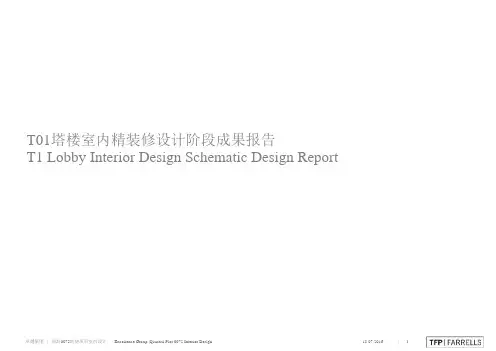



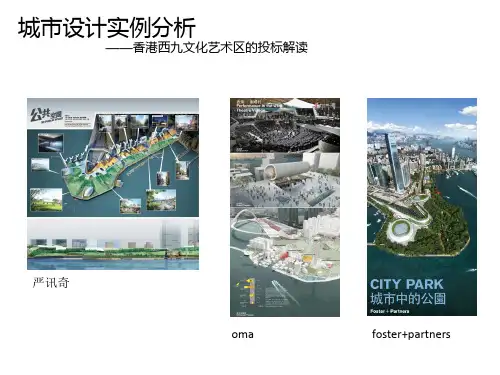
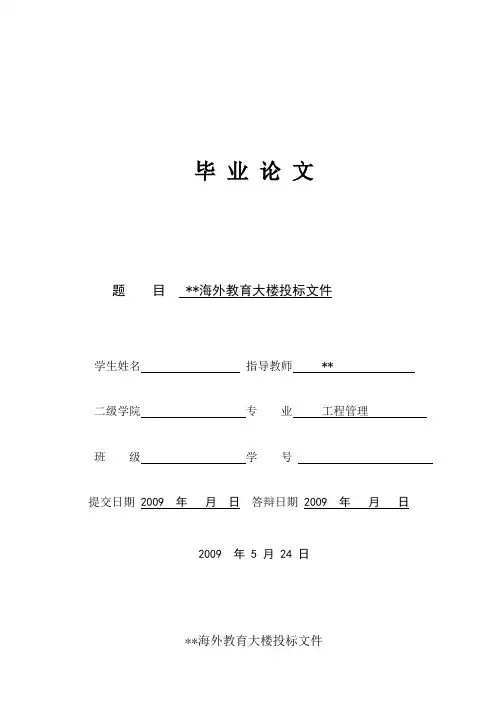
Hong Kong Geopark (香港地質公園)The Hong Kong National Geopark (香港地質公園) opened in November 2009. As the name indicates, this "park" features sites with interesting geology. Rather than being a single area, the geopark includes eight sites (and combinations of sites) in Sai Kung eastern Hong Kong.Here, there are Hong Kong's oldest and youngest rocks, ranging from 400 million to 65 million years old, as well as Hong Kong's star rock formation - the columnar jointed volcanic rocks, of a kind known as tuff.Though elsewhere in the world there are columnar jointed basalt lavas - famously including the Giant's Causeway in Ireland, and Devil's Tower in the US, nowhere else has such extensive or spectacular columnar-jointed tuff. The rock indeed appears to be in columns, with hexagonal cross sections and up to a metre or more across. Other rocks include highly contorted sediments with fossils such as ancient fish, and the finely layered mudstones of Tung Ping Chau.Ma Shi Chau, Lai Chi Chong and Bluff HeadThis "site" spans three localities along the shores of Tolo Channel.Sedimentary rocks are of note here, especially at Bluff Head (above) where the Devonian sandstones, mudstones and conglomerates are the oldest rocks in Hong Kong, dating from around 400 million years ago. They evidently formed on a coastal plain. These rocks have been strongly folded; there are also faults, including one that has (effectively) dropped 250 million year old Early Cretatceous sediments down to form the north of the headland.Bluff Head is tough to reach - accessible only by a boat, or a long hike from near Plover Cove Reservoir, but you can see it from ferries heading out through Tolo Channel.Lai Chi Chong also has sediments, laid down in a lake, with material from eroding volcanoes. There are volcanic rocks, too, especially tuffs formed from volcanic ash.Ma Shi Chau - its Chinese name meaning Horse Excrement Island (!) has old sedimentary rocks you can easily get to. There's a nature trail with information signs, albeit info is not complete. A tombolo - sand spit - leads to the island from neighbouring Yim Tsin Tsai.There are exposures of rocks along the southern coast; though none are really striking, this coast makes for a pleasant walk, and you can see features such as Lung Lok Shui - a hard band of rock people have dubbed a Dragon Diving into the Water, as well as smaller quarzt bands, and ripple like kink-bands on strongly folded, reddish brown sandstone.Double HavenIn the northeast New Territories, Double Haven is a natural harbour ringed by a stretch of mainland coast and the nearby shores of Double Island, Crescent Island and Crooked Island.Here, there are both volcanic and sedimentary rocks, the most striking of which are the ruddy sandstones and siltstones known as "red beds". They formed during deposition in a basin with a desert-like climate, where iron oxidised to result in the strong red colour.Volcanic rocks in eastern Double Haven may have formed locally, as lava squeezed through vents along a small fault. At tiny Ap Chau, northwest of Double Haven proper, the rock is talus, with rough chunks of rock in sandy substrate - it probably formed as debris fell to the base of cliffs that have long since eroded away.Port Island (Chek Chau)Port Island likewise has a mix of volcanic and sedimentary rocks. It's the sedimentary rocks that are of most interest - they are red beds, formed in a large basin that occupied much of present day Mirs Bay. The island's rugged, tough to reach.Tung Ping ChauIn eastern Mirs Bay, Tung Ping Chau is fashioned from the youngest rocks in Hong Kong, roughly 65 million years old. They're mostly fine grained, finely banded mudstones that formed in a lake, which at times dried up or partially dried up in the arid climate. The east coast is gentle, with beaches, and rocks dipping into the sea.There are low cliffs along the western and southern coasts, with features including a far grander Lung Lok Shui (here, has been translated as Dragon Descending to the Water) than at Ma Shi Chau, as well as two small sea stacks on a wave cut platform in the southeast.See also Tung Ping Chau article on this site.Sharp Island (Kiu Tsui Chau)Sharp Island lies just south of Sai Kung - it's easily reached from Sai Kung. The main rocks are volcanic tuffs, together with granite-like quartz monzonite - which may have formed deep within a long gone volcano, together with some sedimentary rocks formed in a basin between volcanoes that were still active.Unless you're a geologist, the rocks aren't exciting to look at (even then, maybe not too thrilling!), but there are also small beaches, with corals close inshore, and a tombolo you can walk across at low tide, to Kiu Tai - where it's fun to scramble over boulders along the coast (take care, though).See also Sharp Island on this site.High Island and Sai WanThe Geopark's key rocks - columnar jointed tuff - formed as a mighty volcano collapsed, in an area that includes the south of the present-day Sai Kung Peninsula in the north, and the Ninepin Group of islands in the south. Incandescent volcanic ash formed thick layers in the caldera, and as it cooled to become rocks, cracks formed, creating hexagonal columns. Occurring around 140 million years ago, this was perhaps the last major event of Hong Kong's four phases of volcanic activity during the Jurassic and Cretaceous periods.There are excellent exposures of this tuff, with the columns very prominent, on the coast near the east dam of High Island Reservoir, and around nearby Po Pin Chau.Ung Kong Group of IslandsLying off the southeast coast of the Sai Kung Peninsula, Bluff Island, Wang Chau and Basalt Island are also made of columnar-jointed tuff (so Basalt Island should perhaps have been named Tuff Island!).Here, there are sea cliffs, including the 140-metre cliffs of eastern Bluff Island - the highest cliffs in Hong Kong, as well as Hong Kong's highest sea arches - a 45-metre high arch through Basalt Island and a 50-metre arch through Wang Chau. At northwest Bluff Island, there's a sheltered cove, with a good coral community.Ninepin GroupThe Ninepin Group - often known as the Ninepins - are likewise formed of the columnar jointed tuff; here, there are columns that are well over a metre wide. Bridled, Roseate and Black-naped terns nest in small colonies, prone to disturbance by people. Looking north over the sea from here, it's hard to imagine that a volcano once towered over the area, and eventually collapsed in a colossal eruption.。
foster + partners: city park福斯特组城市公园foster + partners' masterplan for west kowloon cultural district福斯特组打造西九龙的文化区foster + partners' masterplan for west kowloon cultural district, on a reclaimed harbour-frontsite, has been unveiled in hong kong. 'city park' is a 23-hectare great park and a green avenue which will provide a landscaped setting for a series of spectacular new cultural buildings – the jewels in hong kong’s architectural crown. these new buildings will be approachable and welcoming – places for both high culture and popular enjoyment.在一片新填出的土地,已经规划出一块23公顷土地,未来这里将建成一个公园和森林大道,这将把皇冠上的宝石——该地地标似的建筑衬托得更加绚丽夺目而又如此平易近人,the seventeen new cultural venues include a great opera house; m+ (a pioneering museum of modern art); concert halls; and a 15,000-seat arena with an expo centre below. arts educational facilities, apartments, offices, shops and transport links are to be fully integrated, and 2 kilometres of harbour-front promenade will give the people of hong kong their first chance to look back at the city’s iconic skyline. a social focus is created along a new central avenue, extending from canton road in the east to the harbour tunnel mouth in the west, along which a variety of cultural and commercial activities are integrated.规划中,17个文化场馆将包含了一个歌剧院,m+先锋艺术馆,会议中心,一个可容纳15000人的舞台,艺术教育设施,公寓,写字楼,商店和交通设施将充分整合,沿着2千米的滨海长廊将会是观赏香港城市天际线最好的地方。
Italian architects Massimiliano and Doriana Fuksas have won the competition to design a new terminal at Shenzen Bao’an International Airport in China.The 400,000 square metre terminal will be built in three phases, with the final elementscompleted in 2035.Here’s all the info from the architects:Shenzhen is one of the most important industrial and touristical locations of whole China. Shenzhen is located in the southern portion of the Guangdong Province, on the eastern shore of the Pearl River Delta. Neighbouring the Pearl River Delta and Hong Kong , Shenzhen’s location gives it a geographical advantage for economic development.Shenzhen International Airport Terminal will be the gateway to the city of Shenzhen. The first and last image an air traveller has of a city are those created by the traveller’s impression of the airport. T3 in Shenzhen International Airport can positively influence the image that international, national business people and tourists have of Shenzhen.The master plan for Shenzhen Bao’an International Airport intends to offerworld-class transportation services. Achieving this means that Shenzhen airport must be operate at the following levels:Globally - T3 at Shenzhen Bao’an International Airport must serve as the global aviation gateway between China and the rest of the world.Nationally - as the fourth largest following Beijing, Shanghai, and Guangzhou in China, Shenzhen Bao’an International Airport is a trunk of domestic flights and hub of national flights. Enhancement of transfer services between international and domestici flights will improve the distribution of wealth among all Chinese cities.Regionally - Currently, there are more than 40 cities with populations of over one million within hours flying time of Shenzhen. This makes Shenzhen an excellent location for a regional hub. Passengers travelling from neighboring cities could fly to Shenzhen to connect with long distance global flights or flights to other Asian cities.In construction terms, its design optimises the performance of materials selected on the basis of local availability, functionality, application of local skills, and low cost procurement. Remarkably, it will have been designed and built in just few years. For the complete of T3 Shenzhen Bao’an Airport there are three phases.Phase 1 (in 2015)Major facilities in Phase 1 will include the unit terminal with 63 contact gates, the first stage of the APM, traffic system, parking place, landscape, and shopping centre. Train service for APM will not be available until the complete of Phase 2.Phase 2 (in 2025)Expansion after Phase 1 will occur based on masterplan. During Phase 2, the first remote passenger concourse will be constructed to add gates and the satellite terminal with rail stations will be operational. This will require expansion of the APM.Phase 3 (in 2035)Development of the airport’s west side will continue until about 2035 when T3 Shenzhen International Airport will be fully constructed. Phase 3 continues the demand driven development process. The satellite terminal will again undergo expansion and more remote concourse will be added during this decade. And also there will be expansion of Terminal head house. The volume of extension of Terminal head house is going to be glass facade with glass roof so that the extension of building can have continuity in terms of construction material.Consequently this way of extension can have merits not only for the aesthetic reason but also for construction. Designed for maximum flexibility to cope with the unpredictable nature of the aviation industry, like its predecessors, it aims to resolve the complexities of modern air travel, combining spatial clarity with high service standards.Terminal and ConcourseThe passenger terminal and concourse constitute the major portion of the passengers’ perception of an airport. Factors which affect passengers’ impressions include processing times, walking distances, ease of orientation, crowding, and availability of desired amenities. Each of these has been carefully considered in developing the concept for the passenger terminal and concourse.The terminal is open to views to the outside and planned under a single unifying roof canopy. Natural light is coming through the skin that is double skins with pattern. The skin avoids direct sunlight to reduce energy consumption and creates elegant atmosphere. It makes the air travellers have marvellous impression with comfort.TerminalThe plaza provides access to the baggage handling, departures and arrivals hall on the ground floor as well as to the cafes and restaurants, offices and facilities for business meetings. Void in the grand departure hall establishes not only a visual link between different levels but also the passages of natural light to the other levels.The grand departure hall has vast plaza with check-in counters that is brighten elegantly by the diffusion of light from the roof. This provides a pleasant waiting space with check-in desks, an information counter, car rental companies and airline counters. The mega-trusses are used to have this vast closed plaza.Travellers arrives at the terminal at 14m through the car way. The canopy of the airport can make them feel welcome with light effect that is created by double slit of canopy. After check-in two types of travellers, international and domestic departure is going to divide vertically. For international departure travellers has to go down using escalators while domestic travellers go to security area(CIQ) at 14m.ConcourseConcourse area is one of key function area at the airport. Concourse area at T3 Shenzhen International Airport is composed with three levels. Each level is destined for independent function: departure, arrival, and services.The form of the concourse is simple, but elegant. It is also for the consideration of expansion of the airport in the future.The concept of interior space is fluid. There are two different spatial characters in concourse space. One is movement, the other is pause. Retails and waiting lounges will be islands for pause. Especially retails are key-tenant in concourse space, not only for the management of airport but also for the impression of airport with high-services. Retails and waiting lounges seem to be made naturally following spatial fluid.The inner skin is made of very fine net. The movement of this skin gives concourse space elegant atmosphere. When we see the concourse from 14m level it will be marvellous space.。
东莞滨海湾新区威远岛森林公园概念设计国际竞赛报名相关模板Relevant Registration Formats of the International Competition ofConceptual Design for Weiyuan Island Forest Park, DongguanBinhaiwan Bay Area附件1 Appendix 1:设计联合体协议Agreement of Design Consortium 设计联合体协议(参考备用)Agreement of Design Consortium (For Reference)(所有成员单位名称)自愿组成联合体共同参加(项目名称)。
现就联合体投标事宜订立如下协议。
协议(包括但不限于)如下内容:(All members’ names)voluntarily form the joint consortium and apply for (Project name). And regarding this issue, we make an agreement here that will cover the following terms:1、(某成员单位名称)为本项目的联合体牵头单位。
(One member’s name)is the leading member of the consortium of this project.2、联合体牵头单位合法代表联合体各成员负责本项目文件编制和合同谈判活动,并代表联合体提交和接收相关的资料、信息及指示,并处理与之有关的一切事物,负责合同实施、组织和协调工作。
The leading member should be responsible for documentation and contract negotiation, representing all the members to submit and receive all related data, information and instructions and handle all the affairs related, and contract implementation, organization and coordination. 3、设计联合体授权设计联合体牵头单位对设计联合体各成员的资质等级、业务能力、工作业绩等资料进行统一汇总后由设计联合体牵头单位代表人一并提交给主办方,设计联合体牵头单位代表人所提交的资质等级、业务能力、工作业绩等资料代表了设计联合体各成员的真实情况。
那些“落选”的北京大兴机场设计方案,同样很精彩,我喜欢五角星北京大兴国际机场正式开航,如同凤凰展翅。
让我们看看那些“落选”的北京大兴机场设计方案
吧,同样很精彩。
英国福斯特及合伙人建筑设计事务所方案。
中国民航机场建设集团公司、中国北京市建筑设计研究院的联合体方案。
中国上海市华东建筑设计研究院有限公司、新加坡CPG咨询有限公司联合体方案。
美国HOK建筑事务所、荷兰NAC0机场咨询公司的联合体方案。
法国巴黎机场工程公司(ADPi)方案。
英国扎哈·哈迪德事务所等五家联合体方案。
英国奥雅纳工程顾问公司、英国罗杰斯建筑事务所联合体方案。